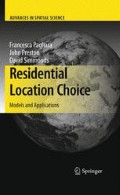Abstract
The DRAM residential model was one of the earliest to be developed and applied, with work beginning in 1971 and with applications in planning agencies continuing to this day. It was developed with the expectation that it would be applied together with an employment model (EMPAL), and with both being linked to a suite of transportation models. This chapter describes the development path of DRAM as well as those of related issues of model calibration and links to other models. The author concludes with the argument that while continued theory development is essential for models such as these, their use as forecasting and policy analysis tools depends as much upon ease of implementation for agency users as it does on any improvement in model formulation.
Access this chapter
Tax calculation will be finalised at checkout
Purchases are for personal use only
References
Anas A (1982) Residential location markets and urban transportation: economic theory, econometrics and public policy analysis. Academic Press, New York
Anas A, Chu C (1984) Discrete choice models and the housing price and travel to work elasticities of location demand. J Urban Econ 15:107–123
Ben-Akiva M, Lerman SR (1985) Discrete choice analysis: theory and application to travel demand. MIT, Cambridge
Casper CT et al (2009) Application of TELUM at Pikes Peak Area Council of Government Metropolitan Planning Organization: Lessons Learned, Paper 09-2697, presented at Transportation Research Board Annual Meeting, Washington, DC. http://www.trb.org/am/ip
Cochrane RA (1975) A possible economic basis for the gravity model. J Transp Econ Policy 9:34–49
Freeman AM (1993) The measurement of environmental and resource values: theory and method. Resources for the Future, Washington DC
McFadden D (1974) Conditional logit analysis of qualitative choice behavior. In: Zarembka P (ed) Frontiers in econometrics. Academic Press, New York, pp 105–142
Neuburger H (1971) User benefit in the evaluation of transport and land use plans. J Transp Econ Policy 5:52–75
NJIT (2009) http://www.telus-national.org/documentationpaper/htm
Pozoukidou G (2005) Increased usability of urban and land use models. The role of knowledge based systems in facilitating land use forecasting to planning agencies, Ph.D. dissertation viewable at. http://repository.upenn.edu/dissertations/AAI3179791
Pozoukidou G (2006) Planning support systems’ application bottlenecks, European Regional Science Association, ERSA conference papers, No. ersa06p769 http://www-sre.wu-wien.ac.at/ersa/ersaconfs/ersa06/papers/769.pdf
Pozoukidou G (2007) Facilitating land use forecasting in planning agencies. In: Kungolos A, Brebbia CA, Beriatos E (eds) Sustainable development III, vol 1. WIT, Southampton, pp 67–80
Putman S (1977) Calibrating a disaggregated residential model – DRAM. In: Batey P, Massey D (eds) Alternative frameworks for analysis, vol 7. Pion, London, pp 108–124
Putman S (1980) Calibrating urban residential location models 3: empirical results for non-U.S. cities. Environ Plann A 12:813–827
Putman S (1983) Integrated urban models: policy analysis of transportation and land use. Pion, London
Putman S (1991) Integrated urban models 2: new research and applications of optimization and dynamics. Pion, London
Putman S, Chan S-L (2001) The METROPILUS planning support system: urban models and GIS. In: Brail R, Klosterman R (eds) Planning support systems: integrating geographic information systems, models, and visualization tools. ESRI, Redlands, California, pp 99–128
Putman S, Ducca FW (1978a) Calibrating urban residential models 1: procedures and strategies. Environ Plann A 10:633–650
Putman S, Ducca FW (1978b) Calibrating urban residential models 2: empirical results. Environ Plann A 10:1001–1014
Putman S, Kim Y-S (1984a) Calibrating urban residential location models 4: effects of log-collinearity on model calibration and formulation. Environ Plann A 16:95–106
Putman S, Kim Y-S (1984b) Calibrating urban residential location models 5: a comparison of trip end and trip interchange calibration methods. Environ Plann A 16:1649–1664
Shen P-N (1995) Optimized network equilibrium models of combined travel and residential location choices. Ph.D. Dissertation, Department of City and Regional Planning, University of Pennsylvania, Philadelphia
Williams HCWL (1976) Travel demand models, duality relations and user benefit analysis. J Reg Sci 16:147–166
Wilson AG et al (1981) Optimization in Location and Transport Analysis. Wiley, Chichester, Sussex
Author information
Authors and Affiliations
Editor information
Editors and Affiliations
Rights and permissions
Copyright information
© 2010 Springer-Verlag Berlin Heidelberg
About this chapter
Cite this chapter
Putman, S.H. (2010). DRAM Residential Location and Land Use Model: 40 Years of Development and Application. In: Pagliara, F., Preston, J., Simmonds, D. (eds) Residential Location Choice. Advances in Spatial Science. Springer, Berlin, Heidelberg. https://doi.org/10.1007/978-3-642-12788-5_3
Download citation
DOI: https://doi.org/10.1007/978-3-642-12788-5_3
Published:
Publisher Name: Springer, Berlin, Heidelberg
Print ISBN: 978-3-642-12787-8
Online ISBN: 978-3-642-12788-5
eBook Packages: Business and EconomicsEconomics and Finance (R0)

